A massage blog or a side hustle blog is not for everybody.
Weren’t expecting that opening, huh?
But it’s true. You may like the idea of a massage blog, but if you don’t like to write it’s probably not a good idea to start a massage blog then.
(There’s a way around that one. It’s called a Vlog. I’ll cover that in another piece.)
Or a blog may be the next shiny object to divert you from the most strategic thing you should be doing right now to grow your massage client list.
This punk loves shiny objects.

Truth-be-told…

…I love this punk.
His name is Rocky, and I have to admit that I’m a lot like Rocky.
I could write a 30,000 word article on how I chased shiny objects instead of doing the next important step for my business, but I’ll save that for another time.
When a Blog Makes Sense
So, those are some reasons for not doing a massage blog. However, there are times when starting a massage blog or any type of blog makes complete sense, like if you’re compelled to write and what you write about is connected to your business.
But if you only have fire in the belly, this is probably what’s going to happen.
Only Fire in the Belly
You crank out your first 2 blog posts no problem. You’re friends and family are supporting you and you’re flying high.
Then the third gets a little harder. The fourth one takes you a month to get out and by the time you get to number five you’re asking yourself: for who, for what?
(Reference: Ricky Watters’ quote. In a game against the New York Giants, Philadelphia Eagles’ running back Ricky Watters didn’t go up for a pass in traffic where he would’ve more than likely been crushed by a defender. After the game, sports reporters asked him why he didn’t go up for the pass. His infamous response: For who, for what?)
Good question, Ricky.
If you’re losing your drive and passion to write your blog, why go on?
What’s the pay-off?
This is where the business part helps.
The Little Equation
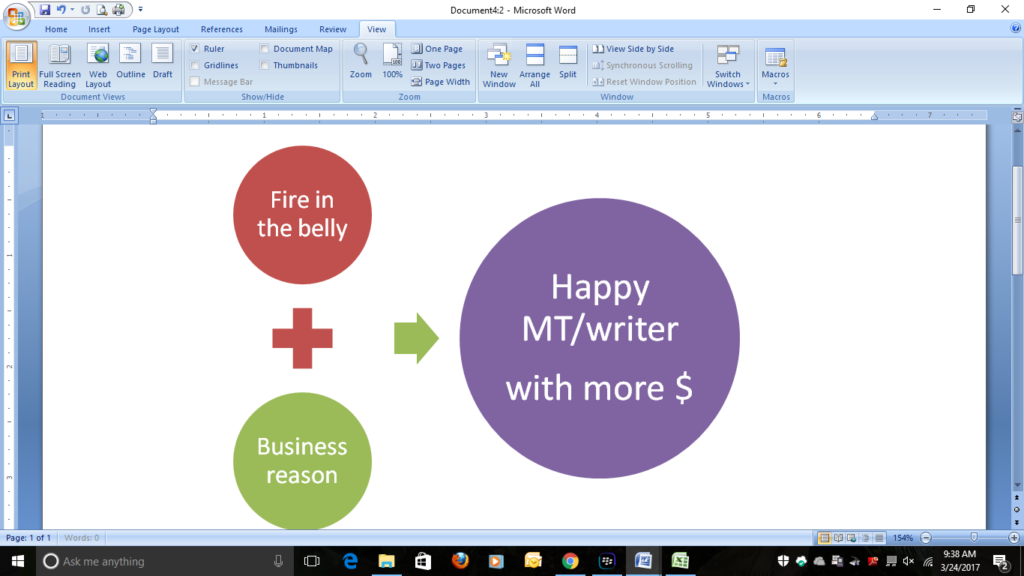
This little equation took me a long time to get mainly because I thought writing should be driven by the sole desire to express something, and business (money) should be a byproduct.
How noble I felt early on in my writing career…and hungry because I didn’t have any money…and depressed because no one wanted to read what I wrote.
But I’m a happy writer when my massage blog produces more customers viewing our website, more customers calling our phone and more referral sources contacting us.
Here’s what a blog could do for you and your business:
The Benefits of a Massage Blog
- Add more credibility to your website.
- Build a stronger relationship with you and potential customers.
- Help convert more website visitors into customers.
- Improve search rankings for website/blog.
- Expand potential referral bases (other health professionals and businesses who see/read your blog).
- Re-engerize you about your massage practice.
Plain and simple, when you write about massage, you learn more about massage. And when you do, you get excited about massage all over again.
More Benefits
- Allow you to work on marketable writing skills.
- Set the stage for blog to article or blog to book.
Think of all the material that you could be covering in your massage blog. I’m sure you can find an article or two or three or four to sell in there. I do this frequently.
When you turn a blog post into an article you get to know a topic inside out, which is good for you and your client, and you have more money in your pocket after you sell the article.
- Be a primer for another blog you want to do.
- Keep you focused on your business path.
If you work for yourself doing massage, you understand that it’s easy to get complacent on the business end of things.
Have you ever had this happen? A regular client goes away for the summer…another one moves…a third one losses her job…and so on… Next thing you know you’re down 5 clients per week because you were sleeping at the wheel. Now it’s going to take you a few months to recoup the losses.
When you’re on schedule with your massage blog, you’re more than likely to be on schedule with your business needs which brings me to benefit # 11.
Benefit #11–My Favorite
- Help you never have to work for someone else again.
When I ask myself if I could work for someone else, my answer isn’t no.
It’s HELL NO!
I’ve tried. And it 100% not for me. Basically it comes down to this, I’m a God-awful, horrible employee because more than anything, I want to work for myself.
A blog is another tool that helps keep me independent.
Now that we got through the “why” to blog, what about the “what” to blog about?
What to Blog About
Take a deep breath because I’m going to ask you do some thinking and planning. This is important because you’re sure to fail if you have a couple of ideas that seem really cool but you don’t actually have a plan.
First, pick one or two overarching topics to cover in your massage blog and that’s it.
Why?
Because one goal of your blog is to attract, inform and hold the attention of the viewers so that they call you for a massage.
To me, generic information—the latest study said that massage might be better than chiropractic for pain relief but only on Tuesdays after the full moon…–is not giving my client anything that she can say wow, Mark is really giving me some valuable information or Mark really knows what he’s doing.
In fact, I may be in danger of boring her to death.
Go Deep
Instead drill down on topics that are core to your massage practice. If you do relaxation massage focus in on relaxation massage and relaxation related topics. That will help attract the customers who want relaxation massage
In addition, going deep into a topic will give you enough information to turn blog posts into articles that you can then sell.
Let’s use a blog focused on relaxation massage as an example.
Here are some relaxation massage and related topics:
- Where the heck did relaxation massage start?
- What makes relaxation massage relaxing?
- Is Swedish massage relaxation massage?
- Can Shiatsu and acupressure (static pressure) be relaxing?
- Why not drink a beer instead of getting a relaxation massage?
- Don’t be nervous; here’s what to expect when you get a relaxation massage.
- My first relaxation massage experience. (From your—the MT’s— history.)
Include Topic-Related Material
- Is rejuvenation the same thing as relaxation?
- Meditation, yoga and massage have this in common.
- Which way of breathing helps you relax the best, yoga or Pilates?
- Instant mindfulness: an interview with a local Qigong teacher.
- How a novice can use imagery to relax.
- The easiest meditation method according to…
The list goes on…
What if Your Blog is Not About Massage?
Same strategy applies.
1. Know your audience.
If you want to start a fitness blog for personal training side hustle, ask yourself: What do I bring to the table?
Maybe you’re really good with stretches. So, a chunk of your blog content could be on stretching.
Like: What are the safest stretches for the piriformis?
2. Go deep instead of broad.
Continuing with the example of stretching in a fitness blog, going deep could be writing a blog post like: Is passive piriformis stretching better than active stretching?
The more you write, the more ideas you’ll have.
And about a year in, you’ll never feel like your running out of ideas.
Turn a Blog Post into an Article
Now you can take one of these posts and expand it into an article or combine multiple posts to create an article.
This is called re-purposing your work. It’s a great way to maximize the payoff for your writing effort.
This is my most recent blog to article:
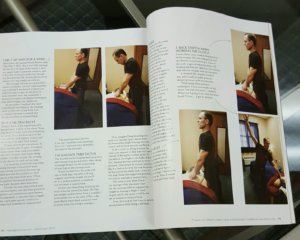
Back to the relaxation massage example, here’s an idea for a massage magazine: Three ways for a stressed out client to do relaxation breathing while on the table with a sidebar on how to practice breathing and mindful meditation while driving.
You can also re-purpose material on social media.
Re-purposing Content on Social Media
For our massage blog, I focus on runners because we bring in a lot of runners from the local running store.
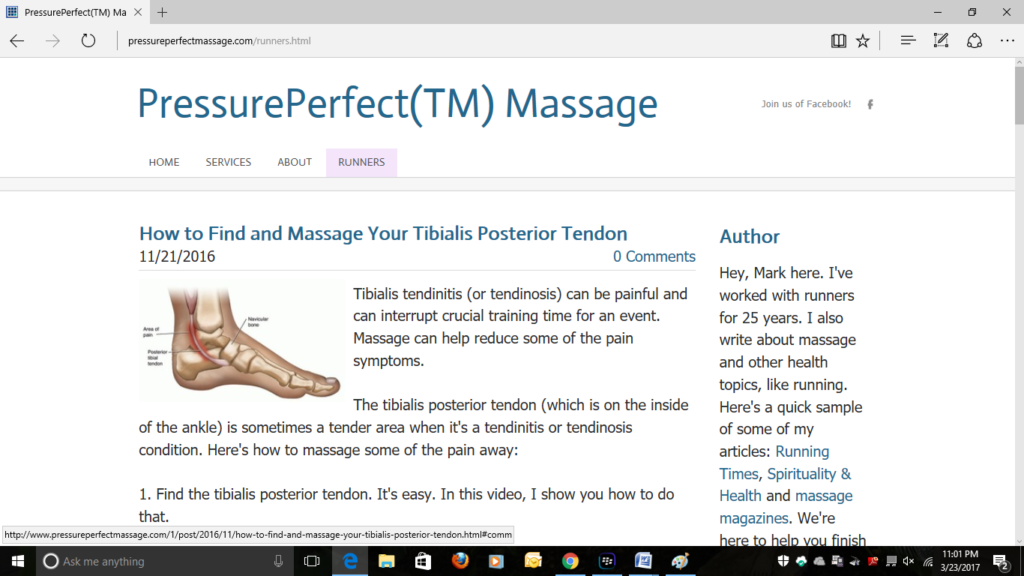
I re-purpose some of the blog videos by posting them on our Facebook page or my YouTube channel. Sometimes I’ll send a link to a video in an email blast to our customers.
You can check out my massage blog here.
When Should You Post?
Okay, that’s “why” and “what”, now let’s do “when”. When should I do my first post?
Now.
What?!
I know, that’s a lot of pressure, but this tip is going to make it easier: For your first couple of posts, don’t pick hard things to write about. Draw mainly from your experience, like “My First Relaxation Massage” or “How to Do a Relaxing Self-Massage”.
And keep it short 500 to 750—ish words.
As you’re writing, keep telling yourself that you’ll be able to get a post out faster in 3 to 6 months. Which leads us to how often should you post?
Personally, if it were just for my business, I’d start with posting once a month as a goal.
But if the massage blog was related to establishing a writing side gig, I’d shoot for every other week.
If you’re having trouble envisioning all this, try making a editorial calendar. That means pick a topic and due date and mark it on a calendar. A good editorial calendar is planned out months in advance. Talk about holding you accountable… Here’s what one looks like:
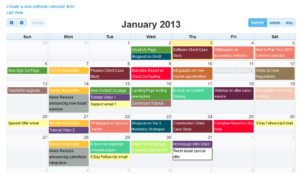
Here’s what mine looks like now:

Remember the shiny object syndrome…yeah…that’s sort of what happens to my writing schedule…
If an editorial calendar reduces your stress, do it. If it adds to it, let it go for now.
Enough “what”, let’s do the “how”.
How do I Create a Blog?
I’m going to show you two ways to do the “how”. One way is to do a Weebly blog and the other way is to do a WordPress blog.
From here on out, whenever I say Weebly blog or WordPress blog, think website and blog rolled together. This will make sense when you watch the videos.
Here’s how to pick when deciding between Weebly or WordPress.
If you want super easy and you’re only planning on doing a blog for your business, go with Weebly.
If you’re more serious about blogging and writing, go with WordPress.
And if you still can’t decide, jump ahead to the videos at the end of this article and have a peek.
Next, if you have a website up and running already, check to see if there’s a blog option in your website builder. If so, you’re good to go. Just look for blog tutorials using your website builder on YouTube.
If you don’t have a website or your website doesn’t have a blog option or you just want to start new, I’m going to show you how to set up a Weebly blog and a WordPress blog.
It takes two steps.
Step #1: Pick a Website Host and Domain Name
A host is a company that provide web space for you on a server.
There are a ton of hosts out there. Here’s a list of some popular Web-Hosting-Services.docx (5 downloads) .
I use Bluehost for a few reasons.
- It’s one-stop-shopping. You get your domain name when you sign up with them.
- It’s really easy to get started.
- And they provide really good support.
About needing support…I’m like Lucy in the chocolate factory when it comes to technology. Once I erased my entire WordPress blog. Oops.
When I called them (about 1 AM on a Sunday), they restored my WordPress blog within a few minutes.
Since then, I seriously abuse their phone service. I call them about everything, no matter how small the detail.
They don’t seem to mind–either that or they’re playing it safe because the conversation is being recorded.
This is my BlueHost link. If you do buy their hosting service through my link, I will get a commission, but you don’t pay more for using the link and BlueHost has a money back guarantee.
If you choose to go through my link and follow my step-by-step, first I want to say thank you! I really appreciate you supporting my work.
I also want to let you know that I got your back.
In other words, I won’t leave you high and dry if you sign up through my BlueHost link.
Why?
Because when I first started blogging I was lost, and then I spent a lot of money trying to get un-lost.
I want you to skip the lost part.
So, whenever I have a new article or tutorial about blogging, I’ll make sure that you get it.
And if you get stuck with blogging using BlueHost as your hosting service, just email me or ask your question in the comment section below.
I promise to make your blogging experience as smooth and painless as possible.
Think of it as DIY with some extra help from me:-)
Also, if you haven’t checked out my DIY Website Guide, you may want to if you’re blog is going to be part of your website. BUT for now, if you want get cranking on your blog just continue on. We can add in the website later no problem.
Okay, if you want to sign up through my Bluehost link and hate dealing with installation of any kind like my friend Bless…

…just email me, and I’ll set up your blog so that you can make your first post. If you want to do it yourself (it’s not hard to do), read on.
Quick Set-Up
Let’s blow through this set-up. If you go to Bluehost, this is the first screen you’ll see:

Click on the “Get Started” and this will be your next screen:
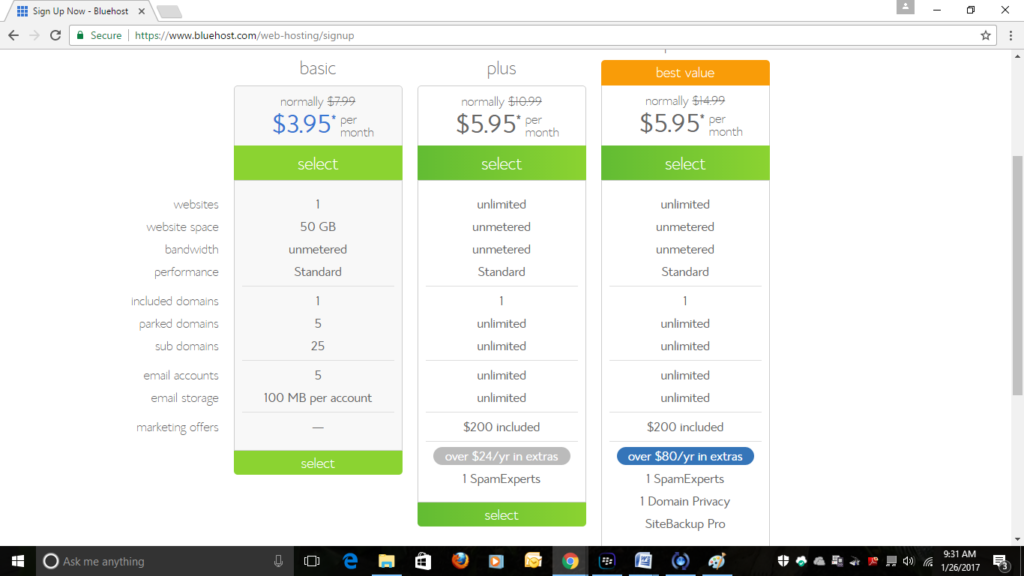
For now, just select the Basic (the cheapest plan) for $3.95/month. You’re not locked in to this package. We will drill down and figure out which package is best for you after the next step. Once you select a package, you’ll be taken to this page:
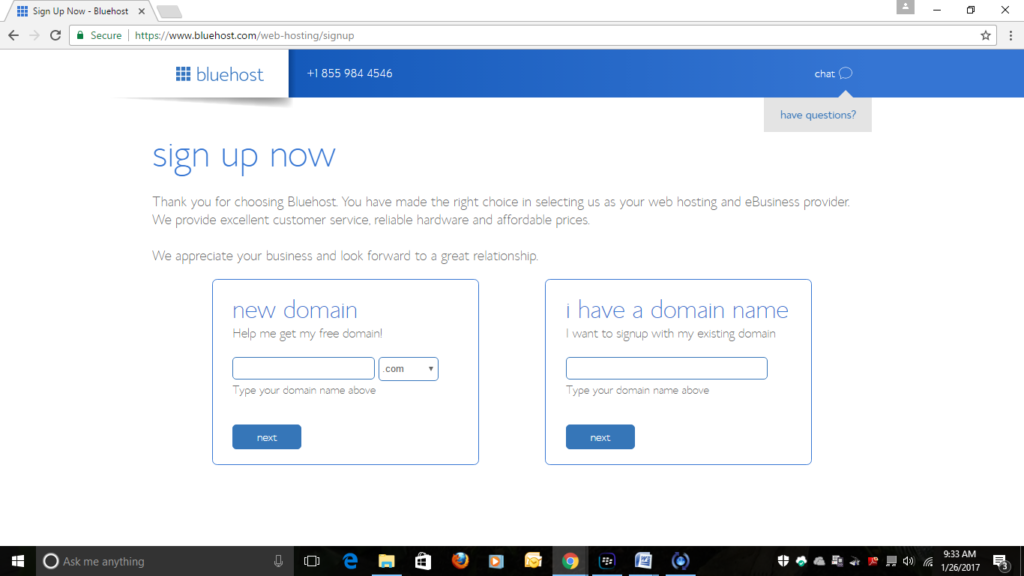
If you have a domain name enter it into the box to the right. If you don’t, decide on one and use the box on the left.
Suggestion: if your domain name is taken, try adding words, like “massage” or “massage therapy”. For us, “pressureperfect” was taken, but “pressureperfectmassage” was not.
If you can’t decide on a domain name just hang out on the page (about 10 seconds or so) and a pop-up will appear which will allow you to continue on without choosing a domain name.
After you select your domain name, you’ll be taken to the Create Your Account page.
Once you fill in the account information, you’ll scroll down to the payment section. It looks like this:
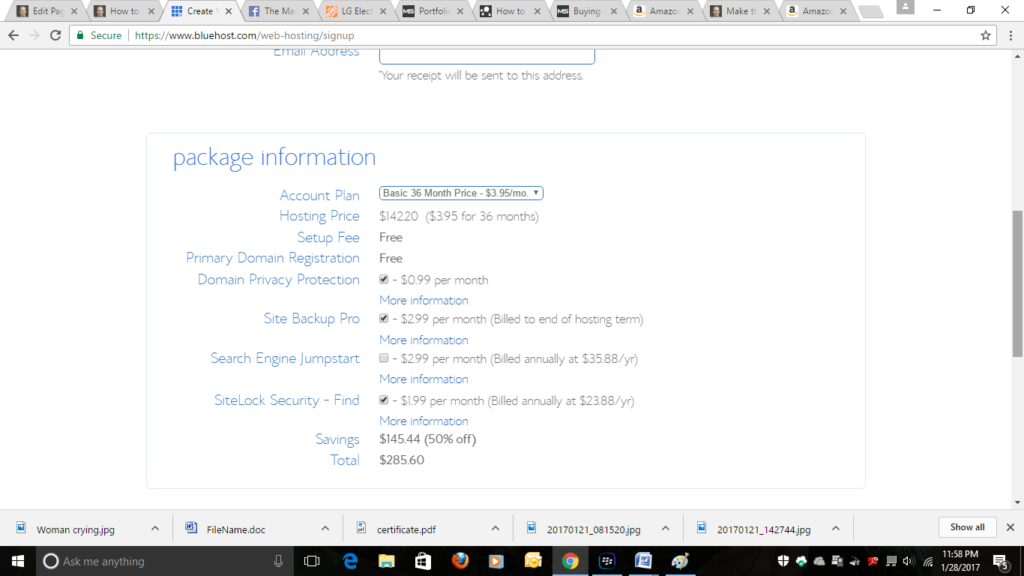
Paying the Least $ as Possible
Okay, so you want to pay attention here. Look at where it says Account Plan. You’ll see that BlueHost has you connected to the cheapest plan at $2.95 per month; however, it’s for 36 months.
With Bluehost you pay for everything upfront. So, over the long run you’ll save money with the 36 months plan, but it’s going to be a bigger initial expenditure than the 12 month plan.
That said, for getting your website up and running for the least amount of money possible, I’d choose the 12 month plan.
Okay, once you choose the length of your plan look below Account Plan.
See all those boxes checked? Un-check them and save yourself more money.
If you’re following my suggestion of 12 month plan with boxes unchecked, your total should be $71.40 and here’s what your screen should look like:

Once you enter your credit card information, you’ll be asked to create a username and password.
Then you’ll be offered more things to buy. Pass on that.
Hit the confirm button.
Done!
You’ll soon have a blog (with a domain name that you own) that will cost you less than $72 for the first year.
BlueHost offers two options for blogs: Weebly and WordPress.
BlueHost automatically installs WordPress to the first domain name you have with them.
Which one should you use?
If you are going to be a serious blogger, I would recommend using WordPress to build your blog.
If you are going to be an occasional blogger and need super easy, use Weebly.
Build a Blog
So, which one are you going with Weebly or WordPress?
Weebly Blog
Okay, if you’re going with Weebly your next step is to uninstall WordPress that was automatically installed to your Domain name.
Omg, Mark, you sucker punched me! I can’t uninstall anything!
Hold on. This is how we are going to make it easy.
Call BLUE HOST support: 888-401-4678
Say to the agent: “I want to use the Weebly sitebuilder for my website, so would you please uninstall WordPress for me?”
The agent will uninstall WordPress. (It should only take minutes.)
When that’s done ask the agent: “Can you please show me how to navigate to my Weebly site builder?”
That’s not hard.
Choose the free version of Weebly to use. Once you’re on your Weebly start building!
You can use two approaches to starting your Weebly massage blog.
One approach is to build your website first, then add the blog. The other approach is to just start the blog and let that serve as your website for now. You can always build the website later.
Pretty freakin’ cool, huh?
Oh, and nothing is set in stone. If you do a Weebly blog now and decide that blogging is really working for you, you can always switch over to WordPress (the better blogging platform) later. No problem. I’ll show you how to do that in upcoming videos.
Here are the Weebly Blog tutorials;
How to do Your First Weebly Blog Post (Blog is the Website)
[embedyt] https://www.youtube.com/watch?v=yYnvVGDdAi8[/embedyt]
How to do Your First Weebly Blog P0st (Blog as Part of the Website)
[embedyt] https://www.youtube.com/watch?v=PmP2awGKyC8[/embedyt]
WordPress Blog
Now for WordPress. Just a heads-up, it won’t be like painting with Bob Ross.
Actually, you’re going to get in there and look at the guts of the blog and say “Oh, crap”. BUT I’m going to make it really, really easy for you because I’ve done all the “Oh, crap”-ing already and have figured things out.
Another heads-up, once you start getting the WordPress system down, you might just get addicted. It’s like decorating a house.
But for now, let’s keep it simple and use the generic WordPress theme (appearance) that was installed automatically to your domain name when signed up with BlueHost.
You can change themes (appearances) later. Some themes cost a small amount of money, but a lot are free.
*In this video you will see that I’m first installing WordPress: DON’T DO THAT. Remember WordPress (and it’s generic theme) we’re automatically installed when you signed up.
[embedyt] https://www.youtube.com/watch?v=X3sD8tcuIYs[/embedyt]
Not bad, huh?
But there’s one more thing you’ll need to know, when you’re ready to publish your first post, your gonna be peeing yourself.
Who’s going to read it? Are they going to hate it? Do I hate it? Did I do a good job proofreading?

Here’s the thing, you’re always going to be second guessing yourself.
Publish it.
You can always go back and make edits at anytime.
Here’s what happens to you when you publish it:

Oh, yeah! You’re gonna feel good!
When you get a chance, send me a link. I’d love to see what you’ve done!
The Short Version
Here’s a recap of the whole shebang without the “talking you through all the parts”.
- Pick a Web Host.
I recommend Bluehost.
- Pick a Domain Name.
With Bluehost, you do this during the same step when you sign up with them.
Suggestion: if possible your domain name should be the name or close to the name of your business.
If your domain name is taken, try adding “therapy”. For example, MonicaMassage.com is taken. Try MonicaMassageTherapy.com.
Or stick with MonicaMassage but add a different suffix: MonicaMassage.net or MonicaMassage.biz.
- Set up your massage blog on Weebly or WordPress and write your first post.
Here are the tutorials to get help you get your first blog post out there. Remember that it doesn’t have to be perfect. In fact, it won’t be–but it will work!
Weebly #1: How to do Your First Weebly Blog Post (Blog is the Website)
Weebly #2: How to do Your First Weebly Blog Post (Blog as Part of the Website)
WordPress: How to do Your First WordPress Post
One more time!

P.S. If you’re struggling with something, jump on my email list. Once I know what you need help with, I can send the right videos, tutorials and articles. The email group is free and you can unsubscribe anytime.
[contact-form][contact-field label=’Name’ type=’name’ required=’1’/][contact-field label=’Email’ type=’email’ required=’1’/][/contact-form]
.



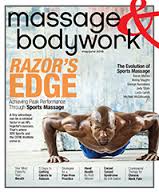
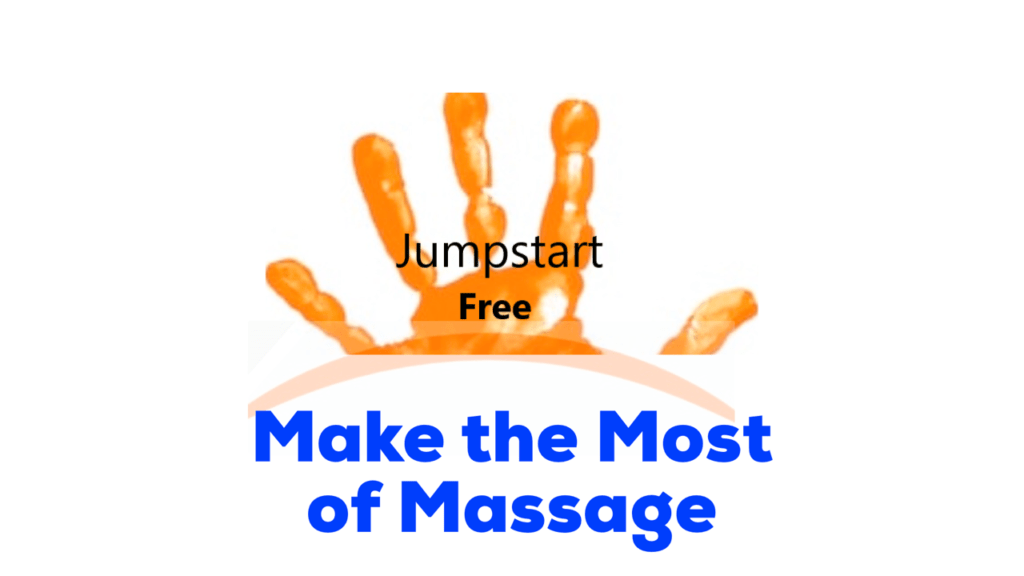

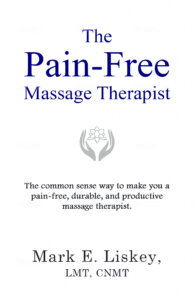
Comments on this entry are closed.